
| R | 3 | 4 | 5 | 6 | 8 | 10 |
| 12 | - | - | - | - | - | - |
Convex Polyhedra containing Rhombi as found in the Rhombic Dodecahedron
The Rhombic Dodecahedron ('RD') is the dual to the cuboctahedron. It is formed from 12 identical rhombic faces. These faces have an acute angle of 2arc-tan(1/sqrt(2)) or 70.529 degrees. They do not appear to have any specific name, so I shall refer to them in this page as 'RD-rhombi', although I have heard them referred to as sqrt(2)-rhombi as the ratio of the diagonals is sqrt(2).
A number of polyhedra can be formed containing such rhombi. They can be simply divided into two categories:
I endeavour to list on this page all known polyhedra which meet the following criteria:
Index: 8 polyhedra in total
Rhombic Dodecahedron: 1 polyhedron
Expanded Rhombic Dodecahedra and family: 3 polyhedra
Tetrahedrally Expanded Rhombic Dodecahedra and family: 3
polyhedra
Hexagonal Square Barrel: 1 polyhedron
Credits
Related Pages
 |
||||||||||||||
|
Commentary: The Rhombic Dodecahedron can be reduced, but the resulting rhombic hexahedra (A and B) are rhombo-flexible.
2. Expanded Rhombic Dodecahedron and related polyhedra
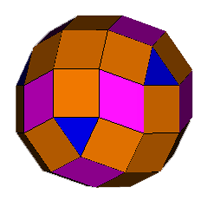 |
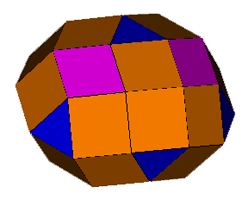 |
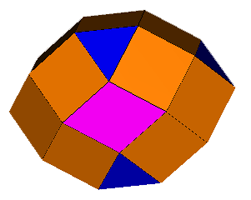 |
||||||||||||||||||||||||||||||||||||||||||
| 2.1 XRD (VRML, OFF) | 2.2 Reduced XRD (VRML, OFF) | 2.3 Twice reduced XRD (VRML, OFF) | ||||||||||||||||||||||||||||||||||||||||||
|
|
|
Commentary: The Expanded Rhombic Dodecahedron ('XRD') can be produced from the Rhombic Dodecahedron by a process of expansion. Each face of the Rhombic Dodecahedron is moved outwards until there is a distance of one unit between each originally adjacent face. These gaps are filled by the insertion of square faces. The remaining holes, corresponding to the original vertices of the Rhombic Dodecahedron can be filled by triangles and further squares. This figure can also form the basis of an interesting toroid.
The XRD contains a total of four 'bands' where all edges are parallel (XRD with one highlighted band). One such band can be removed and the remaining two parts of the XRD moved together to form a new convex polyhedron, this is termed a 'Reduced XRD'. This polyhedron now contains 3 bands each of which is equivalent (reduced XRD with one highlighted band). The process of reduction can be repeated by the removal of a band from the reduced XRD to give a 'Twice Reduced XRD'. This contains two bands, but the removal of either band results in the Johnson Solid 'elongated triangular gyrobicupola (J36)' which contains no rhombi.
George Hart discusses these figures on his page 'Zonish Polyhedra'. George however, constructs them in a different way, starting with the cuboctahedron and adding 'zones'.
3. Tetrahedrally Expanded RD ('TXRD') and related polyhedra
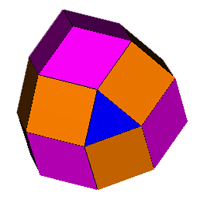 |
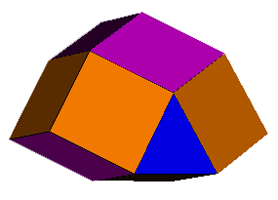 |
 |
||||||||||||||||||||||||||||||||||||||||||
| 3.2 Reduced TXRD (VRML, OFF) | 3.3 Twice reduced TXRD (VRML, OFF) | |||||||||||||||||||||||||||||||||||||||||||
|
|
|
Commentary: The Tetrahedrally Expanded Rhombic Dodecahedron ('TXRD') can be produced from the Rhombic Dodecahedron by a process of expansion. The faces of a Rhombic Dodecahedron are identified in four groups of three faces. Each group of faces is moved outwards until there is a distance of one unit between each originally adjacent face. These gaps are filled by the insertion of square faces. The remaining holes, corresponding to the original vertices of the Rhombic Dodecahedron can be filled by triangles.
The TXRD contains a total of four 'bands' where all edges are parallel (TXRD with one highlighted band). One such band can be removed and the remaining two parts of the TXRD moved together to form a new convex polyhedron, this is termed a 'Reduced TXRD'. This polyhedron now contains 3 bands each of which is equivalent (reduced TXRD with one highlighted band). The process of reduction can be repeated by the removal of a band from the reduced TXRD to give a 'Twice Reduced TXRD'.
George Hart also discusses these figures on his page 'Zonish Polyhedra'. George however, constructs them in a different way, starting with the tetrahedron and adding 'zones'.
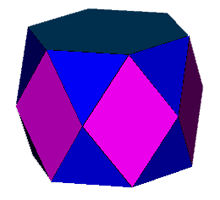 |
||||||||||||||
|
Commentary: The hexagonal square barrel was discovered by Roger Kaufman and is one of an infinite family of polyhedra containing rhombic faces. Only the hexagonal form contains RD-rhombi. (See also the decagonal square barrel). Despite appearances, the hexagonal square barrel cannot be augmented with a triangular cupola as the edge adjacent triangular faces are coplanar.
Roger Kaufman: The Hexagonal Square Barrel and the terms 'rhombo-static' and 'rhombo-flexible'. Roger also introduced me to the TXRD and Twice reduced TXRD (before I found them on George Hart's site).
Convex Polyhedra containing Golden Rhombi
Variations on a Rhombic Theme (non convex
isomorphs to the above)
120° rhombi: Alex
Doskey's: Diamond
Regular Polyhedra
and Steve
Waterman's: Convex
Hulls having Regular Diamonds
Robert Tupelo-Schneck's: Convex
regular-faced polyhedra with conditional edges
108° rhombi: Roger Kaufman's: 108 Degree Rhombohedra
Back: to Deltahedra
and Rhombohedra
Back:
to Index